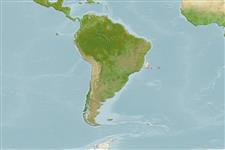>
Eupercaria/misc (Various families in series Eupercaria) >
Scaridae (Parrotfishes) > Sparisomatinae
Etymology: Sparisoma: Latin, sparus = a fish with a golden head + Greek, soma = body (Ref. 45335); rocha: Named for Luiz A. Rocha and additionally 'rocha' means rock in Portuguese, alluding to the volcanic rocky formation of Trindade Island (its type locality); noun in apposition..
Environment: milieu / climate zone / depth range / distribution range
Écologie
marin récifal; profondeur 10 - 25 m (Ref. 84274). Tropical
Southwestern Atlantic: off Brazil, Trindade Island.
Taille / Poids / Âge
Maturity: Lm ? range ? - ? cm
Max length : 30.5 cm SL mâle / non sexé; (Ref. 114982)
Description synthétique
Morphologie | Morphométrie
Épines dorsales (Total): 9; Rayons mous dorsaux (Total): 10; Épines anales 3; Rayons mous anaux: 9. This species is distinguished from its Southwestern Atlantic congeners by the following unique colour characters: initial phase (IP) is red overall with a brownish shade from lower jaw to over the abdominal cavity, sparse orange blotches on head, and a pale circumpeduncular band. The terminal phase (TP) on the other hand is reddish brown with orange stripe from jaw angle to end of preopercle, sparse orange blotches on head, with 3 pinkish to reddish stripes from about midline to dorsum, from midline to belly pale greyish green to whitish with suffusion of pale reddish brown, a black spot on base of pectoral fins and a bright-yellow blotch below this spot. Furthermore, mitochondrial 12S and 16S rRNA loci sequences do not match any known Sparisoma species (Ref. 84274).
This species is a scraper and has been recorded to graze upon epilithic algae growing on rocky and calcareous substrata at 10-25 m depth. The males are solitary, whereas the females may be seen alone or in couples and accompanied by juveniles. These juveniles are small, about 2-5 cm, and associate with mixed groups of the labrids Halichoeres penrosei and Thalassoma noronhanum, which have a similar colour pattern. This association may be considered as a form of social mimicry (Ref. 84274).
Life cycle and mating behavior
Maturité | Reproduction | Frai | Œufs | Fécondité | Larves
Pinheiro, H.T., J.L. Gasparini and I. Sazima, 2010. Sparisoma rocha, a new species of parrotfish (Actinopterygii: Labridae) from Trindade Island, South-western Atlantic. Zootaxa 2493:59-65. (Ref. 84274)
Statut dans la liste rouge de l'IUCN (Ref. 130435)
Menace pour l'homme
Harmless
Utilisations par l'homme
Plus d'informations
PaysZones FAOÉcosystèmesOccurrencesIntroductionsStocksÉcologieRégime alimentaireÉléments du régime alimentaireConsommation alimentaireRation
Noms communsSynonymesMétabolismePrédateursÉcotoxicologieReproductionMaturitéFraiRassemblement de ponteFéconditéŒufsDéveloppement de l'œuf
Taille/ÂgeCroissanceLongueur-poidsLongueur-longueurFréquences de longueursMorphométrieMorphologieLarvesDynamique des populations larvairesRecrutementAbondanceBRUVS
RéférencesAquacultureProfil d'aquacultureSouchesGénétiqueElectrophoresesHéritabilitéPathologiesTraitementNutrientsMass conversion
CollaborateursImagesStamps, Coins Misc.SonsCiguateraVitesseType de nageSurface branchialeOtolithesCerveauxVision
Outils
Articles particuliers
Télécharger en XML
Sources Internet
Estimates based on models
Preferred temperature (Ref.
123201): 25.5 - 27.4, mean 25.8 °C (based on 4 cells).
Phylogenetic diversity index (Ref.
82804): PD
50 = 0.5000 [Uniqueness, from 0.5 = low to 2.0 = high].
Bayesian length-weight: a=0.01122 (0.00665 - 0.01894), b=3.10 (2.95 - 3.25), in cm total length, based on LWR estimates for this species & Genus-body shape (Ref.
93245).
Niveau trophique (Ref.
69278): 2.0 ±0.1 se; based on size and trophs of closest relatives
Résilience (Ref.
120179): Haut, temps minimum de doublement de population inférieur à 15 mois (Preliminary K or Fecundity.).
Fishing Vulnerability (Ref.
59153): Low to moderate vulnerability (27 of 100).
